
Concrete Pumping (BBCP)
Concrete Pumping is up against the odds. Its sales have underperformed and its low returns on capital show it has few growth opportunities.― StockStory Analyst Team
1. News
2. Summary
Why We Think Concrete Pumping Will Underperform
Going public via SPAC in 2018, Concrete Pumping (NASDAQ:BBCP) is a provider of concrete pumping and waste management services in the United States and the United Kingdom.
- Annual sales declines of 4.9% for the past two years show its products and services struggled to connect with the market during this cycle
- Falling earnings per share over the last two years has some investors worried as stock prices ultimately follow EPS over the long term
- Projected sales decline of 2.2% over the next 12 months indicates demand will continue deteriorating


Concrete Pumping is skating on thin ice. We believe there are better businesses elsewhere.
Why There Are Better Opportunities Than Concrete Pumping
High Quality
Investable
Underperform
Why There Are Better Opportunities Than Concrete Pumping
At $6.64 per share, Concrete Pumping trades at 50.5x forward P/E. The current multiple is quite expensive, especially for the tepid revenue growth.
We prefer to invest in similarly-priced but higher-quality companies with superior earnings growth.
3. Concrete Pumping (BBCP) Research Report: Q2 CY2025 Update
Concrete and waste management company Concrete Pumping (NASDAQ:BBCP) reported Q2 CY2025 results beating Wall Street’s revenue expectations, but sales fell by 5.4% year on year to $103.7 million. The company’s full-year revenue guidance of $385 million at the midpoint came in 0.5% above analysts’ estimates. Its GAAP profit of $0.07 per share was in line with analysts’ consensus estimates.
Concrete Pumping (BBCP) Q2 CY2025 Highlights:
- Revenue: $103.7 million vs analyst estimates of $100.3 million (5.4% year-on-year decline, 3.3% beat)
- EPS (GAAP): $0.07 vs analyst estimates of $0.06 (in line)
- Adjusted EBITDA: $26.84 million vs analyst estimates of $27.2 million (25.9% margin, 1.3% miss)
- The company reconfirmed its revenue guidance for the full year of $385 million at the midpoint
- EBITDA guidance for the full year is $97.5 million at the midpoint, above analyst estimates of $95.21 million
- Operating Margin: 12.5%, down from 15.2% in the same quarter last year
- Free Cash Flow Margin: 4.2%, down from 24% in the same quarter last year
- Market Capitalization: $352.2 million
Company Overview
Going public via SPAC in 2018, Concrete Pumping (NASDAQ:BBCP) is a provider of concrete pumping and waste management services in the United States and the United Kingdom.
The company operates under several established brands, including Brundage-Bone Concrete Pumping for U.S. concrete pumping, Camfaud Group Limited in the U.K., and Eco-Pan for waste management services in both regions.
The company has expanded its reach through numerous strategic acquisitions, establishing a strong presence across both countries. Concrete Pumping Holdings utilizes a large fleet of specialized pumping equipment, washout pans, and trucks, operated by highly-trained professionals to deliver precise concrete placement and efficient waste management solutions.
Concrete Pumping Holdings operates through three main segments: U.S. Concrete Pumping, U.S. Concrete Waste Management Services, and U.K. Operations. The U.S. Concrete Pumping segment, operating under the Brundage-Bone and Capital Pumping brands, provides operated concrete pumping services across numerous states. The U.S. Concrete Waste Management Services segment, under the Eco-Pan brand, offers full-service, route-based concrete washout solutions. The U.K. Operations segment encompasses both concrete pumping and waste management services in the United Kingdom.
The company's business model is primarily based on negotiated time and volume pricing for concrete pumping services, with additional charges for specific project requirements. For waste management services, Concrete Pumping Holdings utilizes a fixed-fee structure that includes delivery, pickup, and disposal of concrete washout.
4. Construction and Maintenance Services
Construction and maintenance services companies not only boast technical know-how in specialized areas but also may hold special licenses and permits. Those who work in more regulated areas can enjoy more predictable revenue streams - for example, fire escapes need to be inspected every five years. More recently, services to address energy efficiency and labor availability are also creating incremental demand. But like the broader industrials sector, construction and maintenance services companies are at the whim of economic cycles as external factors like interest rates can greatly impact the new construction that drives incremental demand for these companies’ offerings.
Concrete Pumping’s competitors include United Rentals (NYSE:URI), Cemex (NYSE:CX), and Vulcan Materials (NYSE:VMC).
5. Revenue Growth
A company’s long-term performance is an indicator of its overall quality. Any business can put up a good quarter or two, but the best consistently grow over the long haul. Unfortunately, Concrete Pumping’s 5.1% annualized revenue growth over the last five years was tepid. This was below our standard for the industrials sector and is a tough starting point for our analysis.
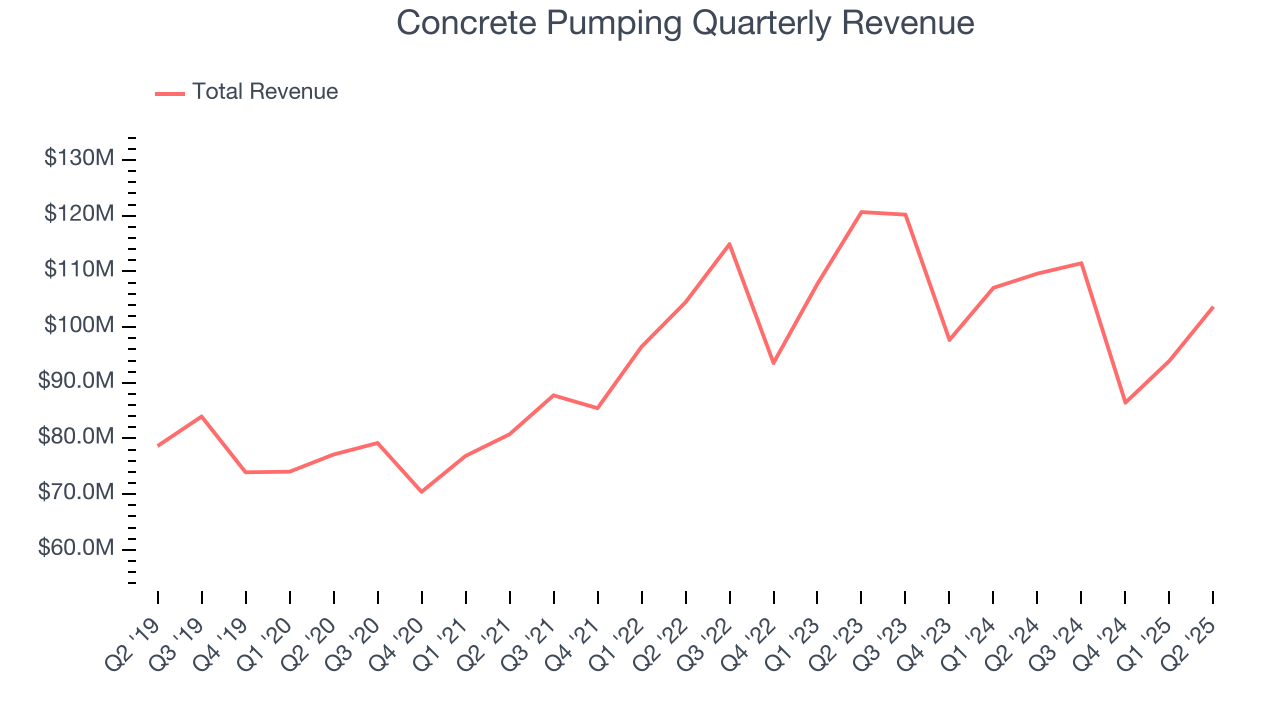
Long-term growth is the most important, but within industrials, a half-decade historical view may miss new industry trends or demand cycles. Concrete Pumping’s performance shows it grew in the past but relinquished its gains over the last two years, as its revenue fell by 4.9% annually. 
This quarter, Concrete Pumping’s revenue fell by 5.4% year on year to $103.7 million but beat Wall Street’s estimates by 3.3%.
Looking ahead, sell-side analysts expect revenue to remain flat over the next 12 months. While this projection implies its newer products and services will catalyze better top-line performance, it is still below the sector average.
6. Gross Margin & Pricing Power
Concrete Pumping’s unit economics are great compared to the broader industrials sector and signal that it enjoys product differentiation through quality or brand. As you can see below, it averaged an excellent 40.5% gross margin over the last five years. Said differently, roughly $40.48 was left to spend on selling, marketing, R&D, and general administrative overhead for every $100 in revenue. 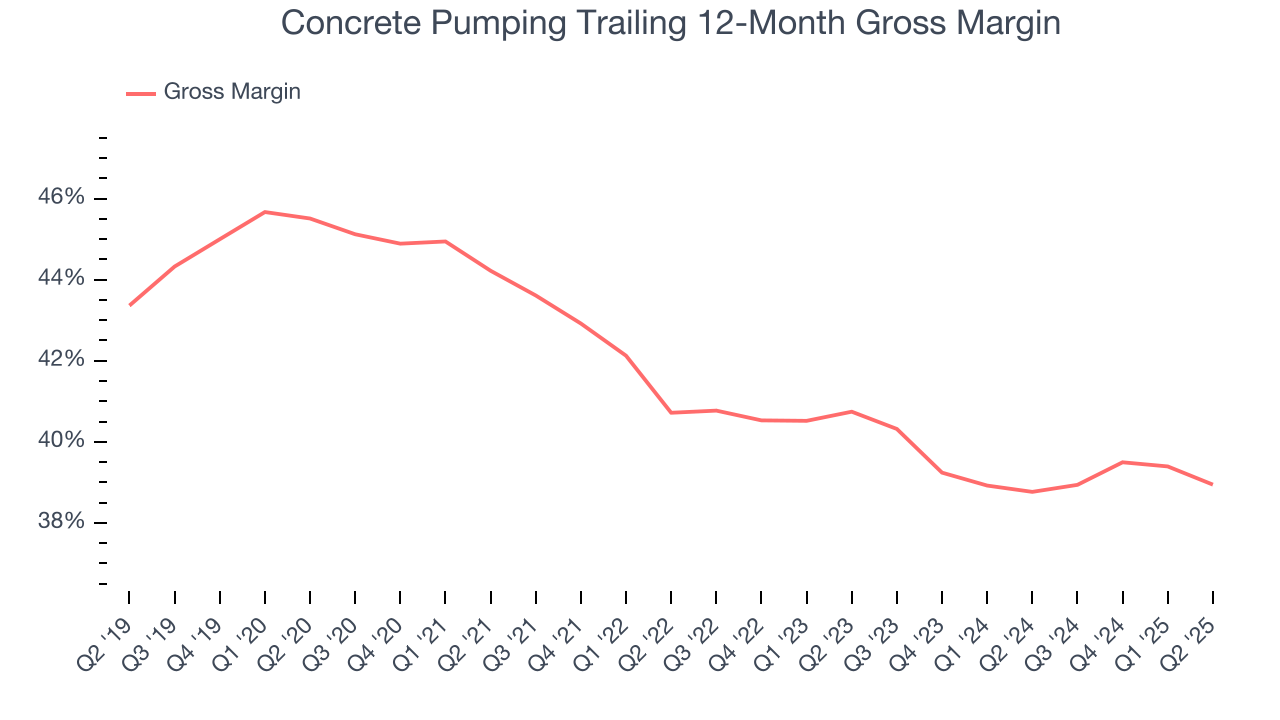
In Q2, Concrete Pumping produced a 39% gross profit margin, down 1.6 percentage points year on year. On a wider time horizon, the company’s full-year margin has remained steady over the past four quarters, suggesting its input costs (such as raw materials and manufacturing expenses) have been stable and it isn’t under pressure to lower prices.
7. Operating Margin
Concrete Pumping has managed its cost base well over the last five years. It demonstrated solid profitability for an industrials business, producing an average operating margin of 11.7%. This result isn’t surprising as its high gross margin gives it a favorable starting point.
Looking at the trend in its profitability, Concrete Pumping’s operating margin rose by 1.1 percentage points over the last five years, as its sales growth gave it operating leverage.
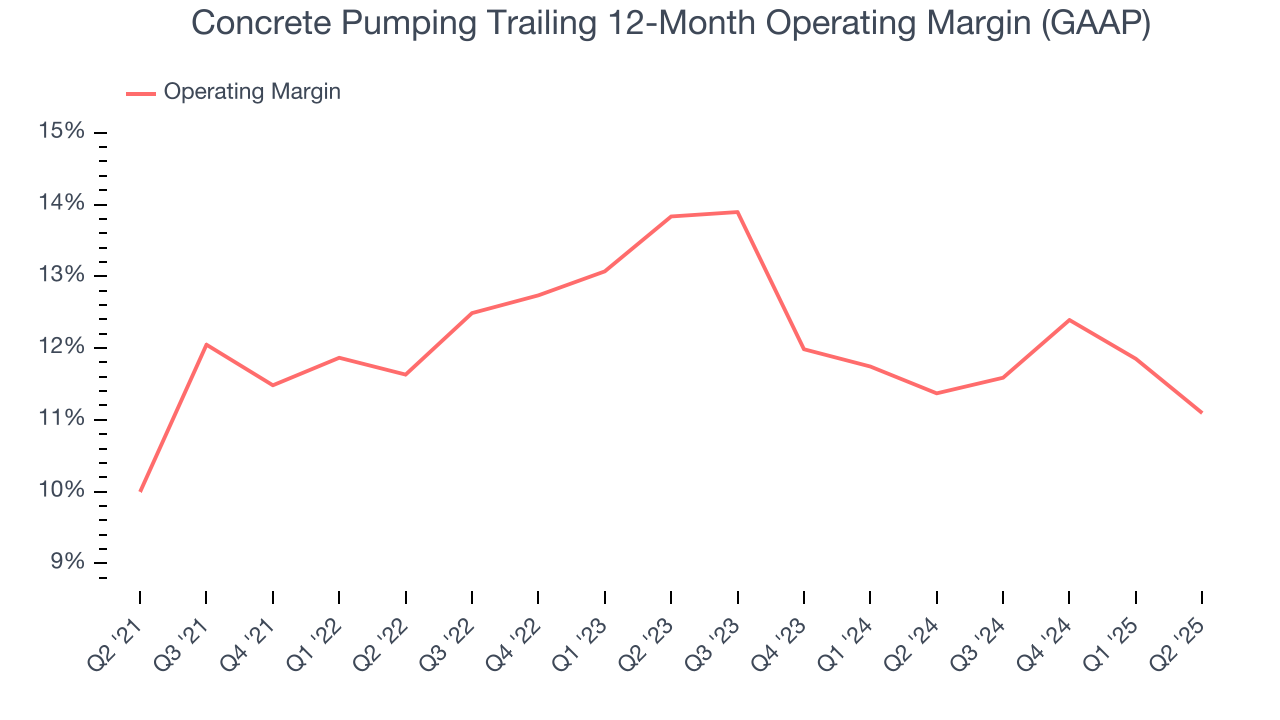
In Q2, Concrete Pumping generated an operating margin profit margin of 12.5%, down 2.7 percentage points year on year. Since Concrete Pumping’s operating margin decreased more than its gross margin, we can assume it was less efficient because expenses such as marketing, R&D, and administrative overhead increased.
8. Earnings Per Share
We track the long-term change in earnings per share (EPS) for the same reason as long-term revenue growth. Compared to revenue, however, EPS highlights whether a company’s growth is profitable.
Concrete Pumping’s full-year EPS flipped from negative to positive over the last five years. This is encouraging and shows it’s at a critical moment in its life.
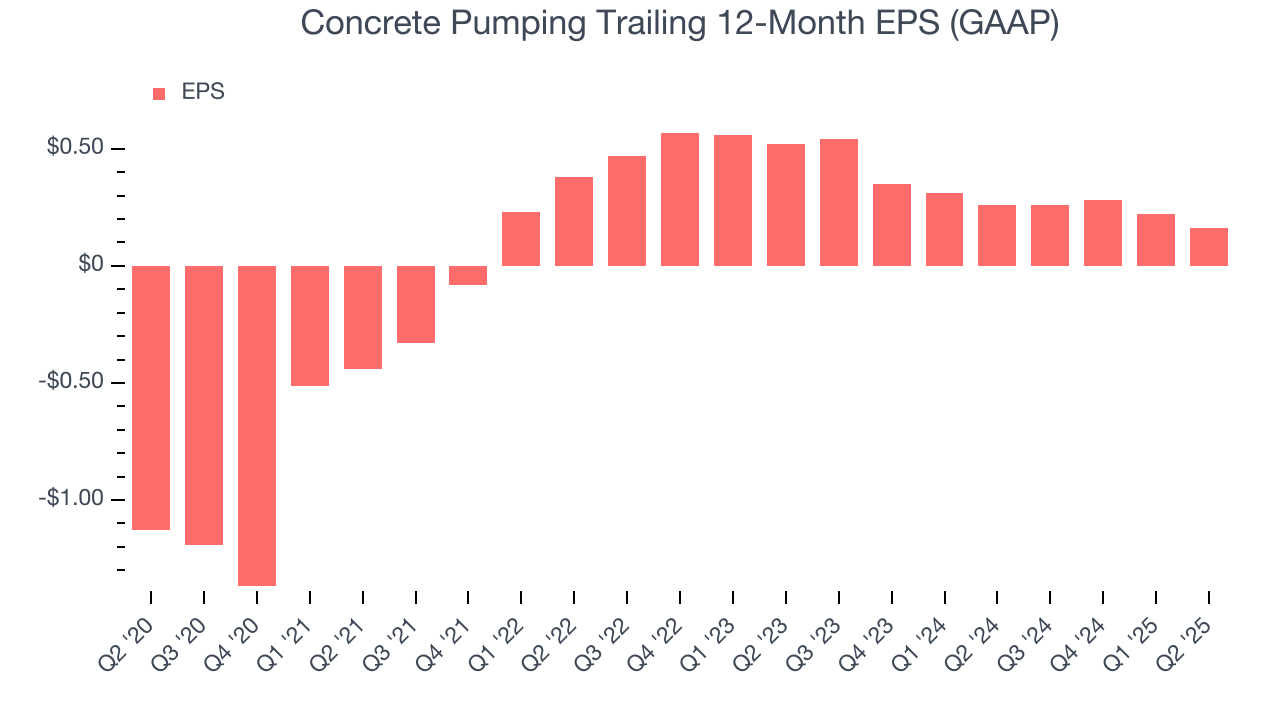
Like with revenue, we analyze EPS over a more recent period because it can provide insight into an emerging theme or development for the business.
Sadly for Concrete Pumping, its EPS declined by more than its revenue over the last two years, dropping 44.5%. This tells us the company struggled to adjust to shrinking demand.
We can take a deeper look into Concrete Pumping’s earnings to better understand the drivers of its performance. Concrete Pumping’s operating margin has declined over the last two years. This was the most relevant factor (aside from the revenue impact) behind its lower earnings; interest expenses and taxes can also affect EPS but don’t tell us as much about a company’s fundamentals.
In Q2, Concrete Pumping reported EPS of $0.07, down from $0.13 in the same quarter last year. Despite falling year on year, this print easily cleared analysts’ estimates. Over the next 12 months, Wall Street expects Concrete Pumping’s full-year EPS of $0.16 to grow 12.5%.
9. Cash Is King
Although earnings are undoubtedly valuable for assessing company performance, we believe cash is king because you can’t use accounting profits to pay the bills.
Concrete Pumping has shown mediocre cash profitability over the last five years, giving the company limited opportunities to return capital to shareholders. Its free cash flow margin averaged 5.7%, subpar for an industrials business.
Taking a step back, we can see that Concrete Pumping’s margin dropped by 7.8 percentage points during that time. This along with its unexciting margin put the company in a tough spot, and shareholders are likely hoping it can reverse course. If the trend continues, it could signal it’s becoming a more capital-intensive business.
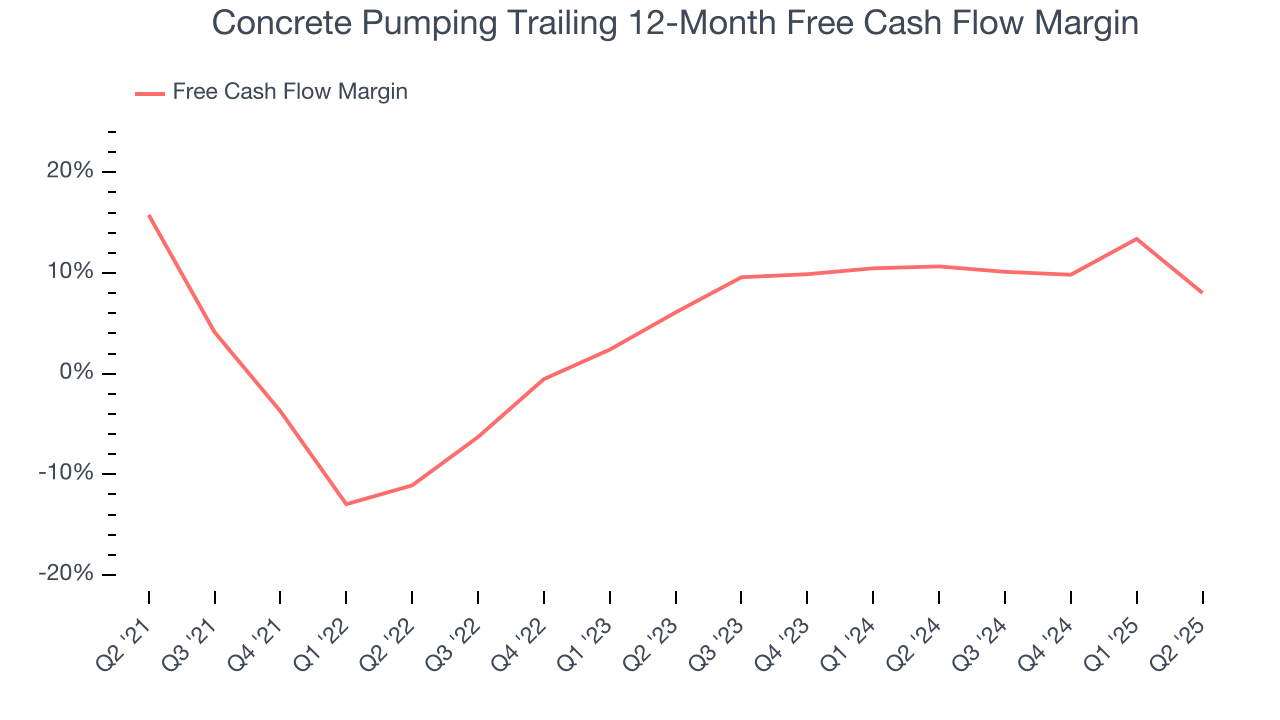
Concrete Pumping’s free cash flow clocked in at $4.34 million in Q2, equivalent to a 4.2% margin. The company’s cash profitability regressed as it was 19.9 percentage points lower than in the same quarter last year, suggesting its historical struggles have dragged on.
10. Return on Invested Capital (ROIC)
EPS and free cash flow tell us whether a company was profitable while growing its revenue. But was it capital-efficient? Enter ROIC, a metric showing how much operating profit a company generates relative to the money it has raised (debt and equity).
Concrete Pumping historically did a mediocre job investing in profitable growth initiatives. Its five-year average ROIC was 7.2%, somewhat low compared to the best industrials companies that consistently pump out 20%+.

We like to invest in businesses with high returns, but the trend in a company’s ROIC is what often surprises the market and moves the stock price. Fortunately, Concrete Pumping’s ROIC averaged 1.5 percentage point increases over the last few years. This is a good sign, and we hope the company can continue improving.
11. Balance Sheet Assessment
Concrete Pumping reported $41 million of cash and $437.4 million of debt on its balance sheet in the most recent quarter. As investors in high-quality companies, we primarily focus on two things: 1) that a company’s debt level isn’t too high and 2) that its interest payments are not excessively burdening the business.

With $100 million of EBITDA over the last 12 months, we view Concrete Pumping’s 4.0× net-debt-to-EBITDA ratio as safe. We also see its $11.95 million of annual interest expenses as appropriate. The company’s profits give it plenty of breathing room, allowing it to continue investing in growth initiatives.
12. Key Takeaways from Concrete Pumping’s Q2 Results
We enjoyed seeing Concrete Pumping beat analysts’ revenue expectations this quarter. We were also glad its full-year EBITDA guidance exceeded Wall Street’s estimates. On the other hand, its EBITDA slightly missed. Overall, we think this was a mixed quarter with some key areas of upside but also some blemishes. The stock remained flat at $6.81 immediately after reporting.
13. Is Now The Time To Buy Concrete Pumping?
Updated: December 4, 2025 at 9:09 PM EST
We think that the latest earnings result is only one piece of the bigger puzzle. If you’re deciding whether to own Concrete Pumping, you should also grasp the company’s longer-term business quality and valuation.
Concrete Pumping doesn’t pass our quality test. First off, its revenue growth was uninspiring over the last five years, and analysts expect its demand to deteriorate over the next 12 months. And while its astounding EPS growth over the last five years shows its profits are trickling down to shareholders, the downside is its projected EPS for the next year is lacking. On top of that, its cash profitability fell over the last five years.
Concrete Pumping’s P/E ratio based on the next 12 months is 51.1x. This valuation tells us it’s a bit of a market darling with a lot of good news priced in - we think there are better stocks to buy right now.
Wall Street analysts have a consensus one-year price target of $7.75 on the company (compared to the current share price of $6.65).
Although the price target is bullish, readers should exercise caution because analysts tend to be overly optimistic. The firms they work for, often big banks, have relationships with companies that extend into fundraising, M&A advisory, and other rewarding business lines. As a result, they typically hesitate to say bad things for fear they will lose out. We at StockStory do not suffer from such conflicts of interest, so we’ll always tell it like it is.











